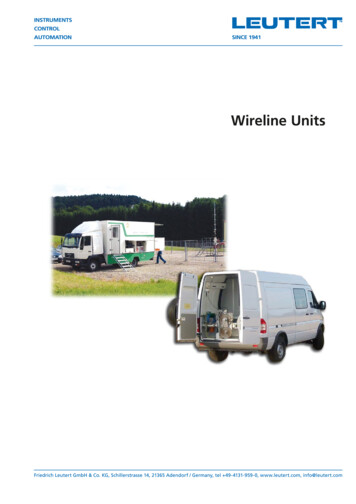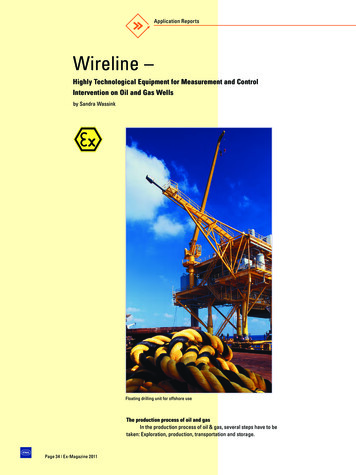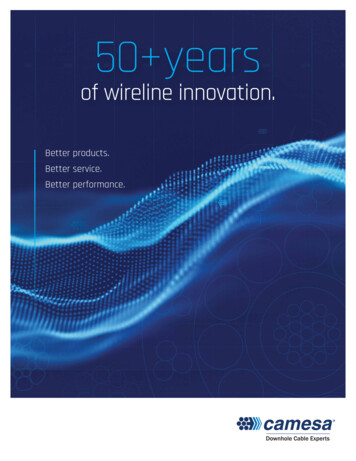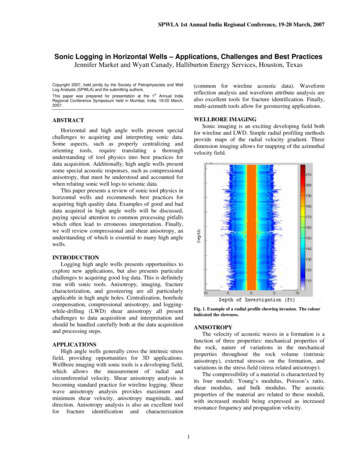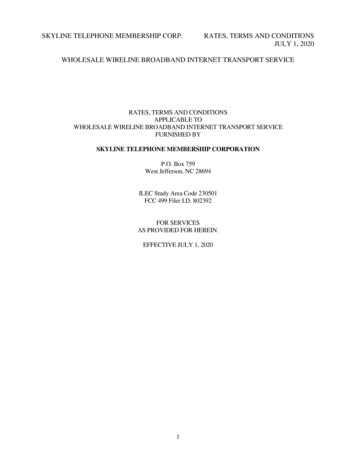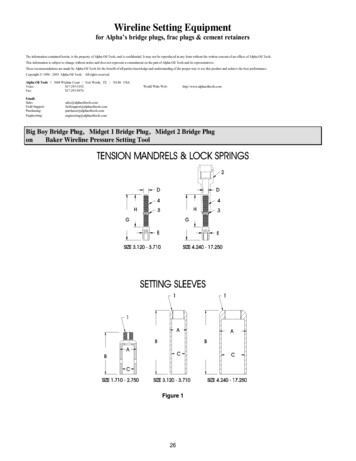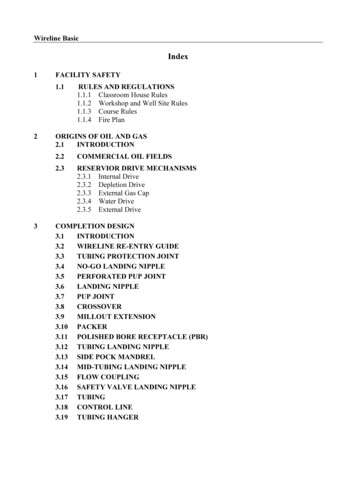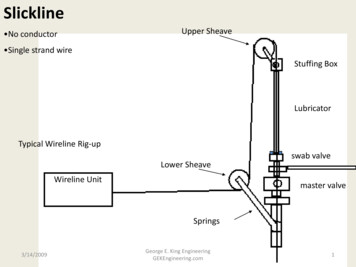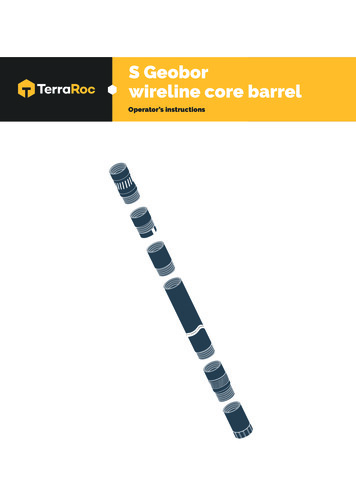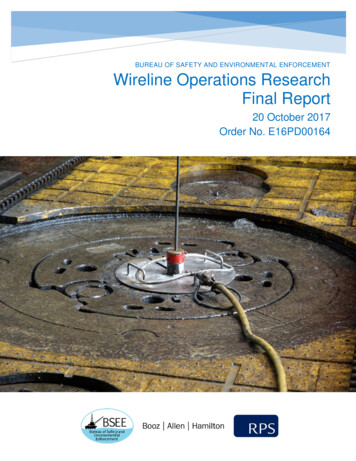
Transcription
Wireline Operations ResearchDraBUREAU OF SAFETY AND ENVIRONMENTAL ENFORCEMENTWireline Operations ResearchFinal Report20 October 2017Order No. E16PD00164
Wireline Operations ResearchFinal ReportTABLE OF CONTENTSACRONYMS AND ABBREVIATIONS .IIEXECUTIVE SUMMARY . III1.0INTRODUCTION . 11.1 WIRELINE OPERATIONS BACKGROUND . 12.0METHODS . 42.1 INDUSTRY SURVEY METHODS . 42.2 GAP ANALYSIS OF U.S. STATES AND IRF COUNTRY REGULATIONS METHODS . 52.3 METHODS FOR MAKING RECOMMENDATIONS . 63.0RESULTS . 63.1 INDUSTRY SURVEY RESULTS . 63.2 GAP ANALYSIS OF U.S. STATES AND IRF COUNTRIES RESULTS . 164.0DISCUSSION. 284.1 INDUSTRY SURVEY DISCUSSION . 284.2 GAP ANALYSIS OF U.S. AND IRF COUNTRY REGULATIONS DISCUSSION . 335.0RECOMMENDATIONS . 375.1 SPECIFY CONSISTENT TESTING AND PERFORMANCE CRITERIA FOR A SUCCESSFUL PRESSURETEST . 375.2 DETERMINE WHAT SHOULD BE CHARTED AND HOW LONG THE PRESSURE TEST MUST BEHELD . 415.3 DETERMINE WHEN IT IS APPROPRIATE TO TEST WITH WELL BORE PRESSURE AND WHATBARRIERS NEEDS TO BE IN PLACE WHEN TESTING . 435.4 FINAL SUMMARY TABLE OF RECOMMENDATIONS . 446.0GLOSSARY . 467.0REFERENCES . 48APPENDIX A WIRELINE OPERATIONS SURVEY QUESTIONS . A-1i
Wireline Operations ResearchFinal ReportACRONYMS AND OWBEWEAWHEWOMPAlaska Administrative CodeAs Low As Reasonably PracticableNational Agency of Petroleum (Brazil)American Petroleum InstituteBlowout PreventerBureau of Safety and Environmental EnforcementCode of Federal RegulationsNational Hydrocarbons Commission (Mexico)Canada-Newfoundland Labrador Offshore Petroleum BoardCanada-Nova Scotia Offshore Petroleum BoardDraft International StandardDet Norske VeritasDet Norske Veritas Germanischer LloydGrease Injector TubeHealth and Safety Executive (United Kingdom)International Association of Drilling ContractorsInstitute of Electrical and Electronics EngineersInternational Regulators’ ForumInternational Standards OrganizationKilopascalsMaximum Anticipated Surface PressureMegapascalsMaximum Working PressureNational Energy Board (Canada)Nautical MilesNational Oceanic and Atmospheric AdministrationNational Offshore Petroleum Safety and Emergency Management AuthorityNorsk Sokkels KonkuranseposisjonNational Oilwell VarcoNew Zealand Petroleum and MineralsOuter DiameterOriginal Equipment ManufacturerPetroleum Safety Authority (Norway)pounds per square inchRecommended PracticeRated Working PressureStatement of WorkUnited KingdomUnintentional Pull-OffWell Barrier ElementsWorking Environment Authority (Denmark)Wellhead EquipmentWell Operations Management Planii
Wireline Operations ResearchFinal ReportEXECUTIVE SUMMARYThe Bureau of Safety and Environmental Enforcement (BSEE) has a mission to promote safety, protectthe environment, and conserve resources offshore. Offshore well blowouts, which are uncontrolledreleases of hydrocarbons to the environment, pose a threat to both the safety of offshore workers and theenvironment. To support BSEE’s ongoing mission, this report evaluates best practices for maintainingwell control and preventing well blowouts during wireline operations and includes recommendations forupdating BSEE’s current wireline pressure testing regulations.Wireline operations are a common method of well operations that involve lowering tools into a well usinga wire or braided cable. These tools are used to conduct a variety of functions throughout the variousphases of exploration and production activities, including well diagnostics, well perforation, completions,and abandonment. When wireline operations are performed on wells under pressure, pressure controldevices, such as wireline rams and wireline lubricators, are used to maintain well control and prevent wellblowouts.To ensure that pressure control devices are capable of maintaining well control and functioning asintended, wireline operators conduct pressure tests on these devices to ensure that they can withstandexpected pressures within the well bore. BSEE regulations in Title 30 of the Code of Federal Regulations(CFR) §250.620 require offshore wireline operators to use a lubricator and at least one set of wirelinerams for wireline operations where there is communication between the hydrocarbon bearing zone and thewell bore, and that the lubricator, once installed on the well, must be pressure tested at the expectedsurface shut-in pressure. BSEE’s regulations are as follows.“Wireline operationsThe lessee shall comply with the following requirements during routine, as defined in §250.601 ofthis part, and nonroutine wireline workover operations:(a) Wireline operations shall be conducted so as to minimize leakage of well fluids. Any leakagethat does occur shall be contained to prevent pollution.(b) All wireline perforating operations and all other wireline operations where communicationexists between the completed hydrocarbon-bearing zone(s) and the well bore shall use alubricator assembly containing at least one wireline valve.(c) When the lubricator is initially installed on the well, it shall be successfully pressure tested tothe expected shut-in surface pressure.”For this study, the research team (1) conducted a survey of industry wireline operators, servicecompanies, and pressure control equipment manufacturers; (2) researched and conducted a gap analysis ofthe wireline operations regulations of U.S. states and the member countries of the InternationalRegulators’ Forum (IRF) and; (3) recommend updates or revisions to BSEE requirements to ensure safeand consistent pressure testing procedures among wireline operators. This report presents the findings ofthe industry survey and regulations gap analysis, as well as our final recommendations to BSEE forupdating and revising the wireline operations regulations in 30 CFR §250.620.INDUSTRY SURVEYA voluntary survey of industry wireline operators was conducted to collect information on currentindustry standards, procedures, and criteria for successful pressure testing during wireline operations.The surveys were composed of approximately 60 survey questions, with minor differences depending onthe specific expertise and operations of the companies.iii
Wireline Operations ResearchFinal ReportThe survey questions developed and distributed to industry participants were based on the following setof five core questions that were provided by BSEE. The full set of about 60 survey questions wasdeveloped to provide additional background and context for these core questions.1. What pressures are used for both routine1 and non-routine operations to test the wireline lubricatorand wireline rams? Are these well bore pressures or pump pressures? Is it acceptable to test withwell bore pressure? If well bore pressure is allowed for testing, when will it be allowed and whatsafety precautions and barriers need to be in place?2. Are the lubricator tests being charted? The current regulations do not state that lubricator tests needto be charted. How are operators verifying that the test is successful if the test is not being charted?3. When are wireline rams used? If wireline rams are used, are the pressure tests being charted?4. What criteria do operators currently use as a successful pressure test of the wireline rams andlubricator?5. Most operators are requesting to lower their test pressure to 1,000 pounds per square inch (psi) whenwireline pressure control equipment is rigged above a rig blowout preventer (BOP). This is adeparture from 30 CFR §250.620(c) to not test to expected shut-in surface pressure when thelubricator is initially installed. The reason operators are requesting this departure is because they saytesting to a high pressure will damage their blind shear rams. Is this reason accurate? Is granting thisdeparture a safe practice? Will the blind shear ram of the rig BOP shear and seal on the wirelinecable? Compare available original equipment manufacture’s (OEM) make, model, and size of blindshear rams for shear and seal. Are the OEM’s claims based on physical testing or modelling? Whattype of damage do operators expect of the blind shear rams due to high-pressure testing?An example set of survey questions is included in this report in Appendix A.Nine oil and gas companies were invited to participate in the survey of wireline operations, standards, andpractices, particularly those related to pressure testing. This included seven wireline operators, onewireline service company, and one BOP manufacturer. Five companies responded to the survey – fourwireline operators and one wireline service company. The other four companies declined to participate inthis study.BSEE regulations in 30 CFR §250.601 define routine operations as follows: “Routine operations mean any of the followingoperations conducted on a well with the tree installed: (a) Cutting paraffin; (b) Removing and setting pump-through-type tubingplugs, gas-lift valves, and subsurface safety valves which can be removed by wireline operations; (c) Bailing sand; (d) Pressuresurveys; (e) Swabbing; (f) Scale or corrosion treatment; (g) Caliper and gauge surveys; (h) Corrosion inhibitor treatment; (i)Removing or replacing subsurface pumps; (j) Through-tubing logging (diagnostics); (k) Wireline fishing; and (l) Setting andretrieving other subsurface flow-control devices.”1iv
Wireline Operations ResearchFinal ReportGAP ANALYSIS OF U.S. STATE AND IRF REGULATIONS METHODSOil and gas regulations related to wireline operations of 13 U.S. states with significant oil and gas activityand 9 IRF countries were researched.U.S. Oil and Gas aliforniaColoradoFloridaLouisianaMississippiNorth DakotaNew YorkOklahomaPennsylvaniaTexasWest VirginiaIRF Member markMexicoNetherlandsNew ZealandNorwayUnited KingdomRelevant laws and regulations were accessed through official government websites of each state orcountry and searched for rules, regulations, legislation, guidance, or policies related to oil and gasactivities applicable to wireline operations. For the IRF countries, BSEE provided contact information tothe research team for conducting telephone interviews to validate and expand upon the online research ofregulations and policies. Each country contact was sent an email invitation requesting a telephoneinterview. Interviews were conducted with representatives from Australia, Canada, New Zealand,Norway, and the United Kingdom. A representative from Denmark responded with detailed informationvia email. The research team was unable to interview regulators from Brazil, Mexico, and theNetherlands.RESULTS AND DISCUSSIONThis section provides a summary of the study findings and resulting recommendations for expandingBSEE’s wireline pressure testing regulations in 30 CFR §250.620. Our recommendations are based onthe three questions posed in the BSEE statement of work (SOW) under Task 2.Specify Consistent Testing and Performance Criteria for a Successful Pressure TestThe study results indicate that pressure tests for wireline pressure control devices should be divided intotwo general categories: field tests, which are performed in the field when the wireline pressure controldevices are installed on the wellhead, and shop tests, which occur in a testing facility and are performedperiodically (e.g., annually).The results from U.S. state and IRF country regulations, as well as reported industry practice from theindustry survey, indicate that field pressure tests are most commonly performed with a low-pressure testbetween 200 psi and 350 psi and with a high-pressure test some margin above maximum anticipatedsurface pressure (MASP). The study results indicate field pressure tests are generally performed when thepressure control equipment is first installed, and after any disconnection and reconnection is made. Mostentities researched (i.e., states, countries, companies, or voluntary standards) specified shop pressure teststhat are performed periodically (either annually or once every five years) with a low-pressure test between200 psi and 350 psi and a high-pressure test at or above the equipment rated working pressure (RWP).v
Wireline Operations ResearchFinal ReportFor pressure testing when rigged above a drilling BOP, some companies appear to be testing theirwireline pressure control equipment only up to 1,000 psi in the field. However, survey participantsreported that field test pressure should be determined by the pressures expected in the well bore, not thelimitations of the BOP blind shear rams. Further, industry participants reported that closing the drillingBOP blind shear rams and subjecting them to more than 1,000 psi from above is also not a safe practice.The blind shear rams are designed to withstand pressure from below, such that pressure forces the ramstogether, resulting in a tighter seal. Pressure from above will tend to pry the blind shear rams apart,potentially leading to leaks and damaging the sealing surface of the rams. Industry participants offeredtwo potential solutions for testing to appropriate pressures when rigged above a BOP. A test plug can beplaced in the well bore below the BOP to create a seal, or a set of inverted blind shear rams could beinstalled on the rig BOP and closed so that they are subject to pressure from the proper direction duringpressure tests.Determine What Should be Charted and How Long the Pressure Test Must Be HeldCharting is the process of making a record of a pressure recording over time during a pressure test.Charting of wireline pressure control equipment pressure tests can be done with circular, analog chartsthat make a paper record, or with digital devices whose results can be saved and viewed on a digitaldevice (Recorders Charts & Pens, Inc, 2017). The study results indicate that charting is nearly alwaysperformed during shop tests because the equipment is readily available at testing facilities. Therefore, ourdiscussion of charting focuses on whether charting is used during field pressure tests.Industry survey participants reported using a mixture of digital charts and analog charts, which aretypically circular paper charts. The study results show a wide variety of acceptance criteria for successfultest pressure holding times and pressure drops. Holding times include 3, 5, 10, and 15-minute periods.Allowable pressure drops also varied and ranged from 0 psi, to a 1% drop, 5% drop, and a 10% drop.This range in practices and requirements suggests that updated BSEE regulations that specify testingprocedures and acceptance criteria would be beneficial by creating more uniform practices amongindustry wireline operators.Determine When it is Appropriate to Test with Well bore Pressure and What Barriers Needs to Bein Place When TestingTo conduct a pressure test in the field, pressure must be introduced to the bodies of the wireline pressurecontrol equipment. This can be done by either using a surface pump or introducing the equipment to thepressure present in the well bore. While testing with well bore pressure may be technically less complexand less costly, it does not allow for testing above the pressure present in the well bore. Testing abovewell bore pressure can only be achieved by using a surface pump.Most of the study results indicate that pressure testing is not performed with well bore pressure, rather itis performed using surface pump-in pressure. In some cases, well bore pressure is used for tests if theinitial pressure test has already been conducted with surface pump-in pressure, or if the well bore pressureis particularly low (e.g., less than 5,000 psi). Most entities researched cited the use of wireline ramsduring any wireline operations under pressure. Wireline rams are not generally used in operations notunder pressure, for example when the lubricator is rigged on top of a drilling BOP and kill-weight fluid2in present in the well bore.RECOMMENDATIONSRecommendations developed from this study are presented in Table ES-1 below. To makerecommendations for updating BSEE wireline pressure testing regulations, the research team reviewed2Kill-weight fluid is defined as an amount or density of drilling fluid that provides hydrostatic pressure toprevent the influx of formation fluids into the well bore (Schlumberger, 2017).vi
Wireline Operations ResearchFinal Reportthe results from the industry survey and the gap analysis of the regulations of U.S. states, IRF countries,and four voluntary consensus standards. In an iterative analysis of results from the survey and gapanalysis, the research team considered what policies and requirements are common among regulators,what practices are already common in industry, and how industry can comply with new requirementswithout an unreasonable burden. We sought to recommend several new requirements for BSEE toconsider, so there would be a ‘menu’ of options from which to choose when considering what newpolicies to codify in the regulations. We are not recommending that the new proposed procedures belowbe adopted simultaneously. Rather, we recommend that BSEE consider each change individually anddetermine which ones should be codified and, if so, on what schedule.Although many of the recommendations would establish substantive new requirements for industry, it isunlikely that any of the proposed changes present a significant new burden because much of industry(based on the survey responses) is already carrying out most of the recommended policies and procedurespresented in Table ES-1below. Overall, our recommendations would make wireline operations moreconsistent across the industry and bring all operators to a common, higher level of safety.Table ES-1. Recommendations for Updated BSEE Wireline Pressure Testing mmendationField pressure tests for wireline rams and lubricatorsConduct field low- and high-pressure tests of the wireline rams and lubricatorwhen installed and after each time a connection is broken. Low-pressure test at any pressure from 250 psi to 350 psi High-pressure test 20% above MASPDepartures from this requirement should not be granted to allow for testing toonly 1,000 psi when rigged above a drilling BOP. When lubricators are riggedabove drilling BOPs, operators should either use a test plug or install invertedblind rams in the BOP stack designed to hold pressure from above to allowpressure testing to 20% above MASP.2Maintenance shop pressure test for wireline rams and lubricatorsConduct low- and high-pressure tests periodically at a pressure test facility. Low-pressure test at any pressure from 250 psi to 350 psi High-pressure test at RWP3Recertification shop pressure test for wireline rams and lubricatorsConduct low- and high-pressure tests annually at a pressure test facility. Low-pressure test at 250 psi to 350 psi High-pressure test at 50% above RWP4Pressure-test chartingAll wireline ram and lubricator field pressure tests must be charted, and recordsof the test results maintained for the life of the well, with the followingexception: For wells with pressure below 1,000 psi, charting is not required;however, operators must document their observation of the pressure testsin a formal record such as a well log Both analog and digital charts are acceptable records5Acceptance criteria for pressure tests.All field pressure tests must be held for a minimum of 5 minutes. Maximum allowable pressure drop: 5%vii
Wireline Operations ResearchFinal ReportCategoryNo.RecommendationTesting withWell BorePressureandRequiredBarriers6Testing with well bore pressureLubricators and wireline rams must be tested with a surface pump to a safetymargin above surface shut-in pressure for wells with more than 1,000 psipressure. Well bore pressure testing is allowable only for wells with surface shut-inpressure of 1,000 psi or less. For these low-pressure wells, the lubricatorand wireline rams may be tested to surface shut-in pressure.7Barriers required for wireline operationsWhen pressure is present in the well bore, all wireline operations must feature atleast one set of wireline rams and one device capable of cutting the wireline cable(e.g., a wireline cutter or a blind shear ram).viii
Wireline Operations ResearchFinal Report1.0 INTRODUCTIONThe Bureau of Safety and Environmental Enforcement (BSEE) has a mission to promote safety, protectthe environment, and conserve resources offshore. Offshore well blowouts, which are uncontrolledreleases of hydrocarbons to the environment, pose a threat to both the safety of offshore workers and theenvironment. To support BSEE’s ongoing mission, this report reviews best practices for maintaining wellcontrol and preventing well blowouts during wireline operations and includes recommendations forupdating BSEE’s current wireline pressure testing regulations.Wireline operations are a common method of well operations that involve lowering tools into a well usinga wire or braided cable. These tools are used to conduct a variety of functions throughout the variousphases of exploration and production activities, including well diagnostics, well perforation, completions,and abandonment. When wireline operations are performed on wells under pressure, pressure controldevices, such as wireline rams and wireline lubricators, are used to maintain well control and prevent wellblowouts.To ensure that pressure control devices are capable of maintaining well control and functioning asintended, wireline operators conduct pressure tests on these devices to ensure that they can withstandexpected pressures within the well bore. BSEE regulations in Title 30 of the Code of Federal Regulations(CFR) §250.620 require offshore wireline operators to use a lubricator and at least one set of wirelinerams for wireline operations where there is communication between the hydrocarbon bearing zone and thewell bore, and that the lubricator, once installed on the well, must be pressure tested at the expectedsurface shut-in pressure. BSEE’s regulations are as follows.“Wireline operationsThe lessee shall comply with the following requirements during routine, as defined in §250.601 ofthis part, and nonroutine wireline workover operations:(a) Wireline operations shall be conducted so as to minimize leakage of well fluids. Any leakagethat does occur shall be contained to prevent pollution.(b) All wireline perforating operations and all other wireline operations where communicationexists between the completed hydrocarbon-bearing zone(s) and the well bore shall use alubricator assembly containing at least one wireline valve.(c) When the lubricator is initially installed on the well, it shall be successfully pressure tested tothe expected shut-in surface pressure.”For this study, the research team (1) conducted a survey of industry wireline operators, servicecompanies, and pressure control equipment manufacturers; (2) researched and conducted a gap analysis ofthe wireline operations regulations of U.S. states and the member countries of the InternationalRegulators’ Forum (IRF) and; (3) recommend updates or revisions to BSEE requirements to ensure safeand consistent pressure testing procedures among wireline operators. This report presents the findings ofthe industry survey and regulations gap analysis, as well as our final recommendations to BSEE forupdating and revising the wireline operations regulations in 30 CFR §250.620.1.1 WIRELINE OPERATIONS BACKGROUNDWireline operations are defined as any oil and gas exploration or production activity that involveslowering a tool into a well bore using a wire or braided cable. While some wireline cables are used onlyto lower and raise tools through the well bore, wireline cables can also be used to conduct electricalsignals from these tools to the surface. Wireline cables can be a single strand or multiple, braided strands.Braided cables are often referred to as wireline, and single-strand cables are referred to as slicklines. This1
Wireline Operations ResearchFinal Reportdistinction is often critical as it is a technical challenge to form a pressure seal around the rough, irregularsurface of a braided cable and easier to form a seal around the smooth surface of a slickline. (RigZone,2017)Wirelines and slicklines are used for a wide variety of purposes throughout the various phases ofexploration and production activities, including well diagnostics, well perforation, completions,abandonment, change zone operations, and other operations requiring permitting from BSEE. Slicklinesare often used to place and retrieve well equipment such as plugs, gauges, and valves. These functions donot require the transmittal of electronic signals through the wire. Operations that use wireline tools tomeasure well characteristics and properties are referred to as wireline logging or well logging. Wirelinelogging tools are lowered into the well bore using a cable and collect data using a variety of methodsincluding electromagnetic and acoustic wave measurements. Wireline logging can measure resistivity,conductivity, formation pressure, temperature, and well bore dimensions.Wireline operations are also used to perforate wells. Perforation is the process that allows reservoirhydrocarbons to freely flow into the well bore, allowing for production. Perforations are also performedto allow fluid to flow from the pipe into an outer annulus, often for the setting of an abandonment plug.In typical operations, a wireline is used to lower a perforating gun into the well bore. The perforating gunfeatures explosives that, when detonated, generate perforations in the well bore casing, creating a pathwayfor hydrocarbons to flow into the well bore. (RigZone, 2017)In a typical configuration, the wireline cable is coiled onto a large drum, then routed through a series ofpullies or sheaves into a vertical orientation before entry to the well (see Figure 1). The wireline operatorrotates this drum to alternately lower (unspool) or raise (spool) the wireline tool. The cable is typicallyrouted through a lubricator, which is a pressure control device used to initially house the tool string andcreate a seal between the outside environment and the pressurized environment in the well. Thelubricator may be assembled on top of wireline rams (sometimes also referred to as a “wireline valve” or“wireline blowout preventer [BOP]”), which are designed to maintain well control (von Flatern, 2014).Figure 1. Diagram of typical wireline or slickline configuration2
Wireline Operations ResearchFinal ReportWireline rams consist of a series of rams, similar to BOP rams; however, wireline rams are often operatedmanually under low well bore pressure conduction (e.g., 1,000 psi) and can be operated hydraulically forhigher well bore pressures. As with BOP rams, there are a variety of designs of wireline rams. Wirelinerams feature a small hole remaining when fully closed, which is designed to accommodate the wirelinecable and create a seal around the cable (see Figure 2) (NOV, 2017a).Figure 2. Diagram of wireline rams sealing around wireline. Arrows represents ram sealingmotion.Blind rams are designed to seal completely and cannot accommodate a wireline cable. Blind shear rams(also referred to as shear seal rams) are designed to cut the wireline cable as they close, then completelyseal off the well bore (see Figure 3). If wireline blind rams are needed to fully seal off the well bore,some wireline operators use wireline cutters, which are devices designed to cut the wireline cable,allowing the cable and associated tools to fall down the well bore in case of an emergency. Cutting thewireline cable will allow the wireline blind shear rams,
These tools are used to conduct a variety of functions throughout the various phases of exploration and production activities, including well diagnostics, well perforation, completions, . wireline pressure control equipment is rigged above a rig blowout preventer (BOP). This is a departure from 30 CFR §250.620(c) to not test to expected shut .
